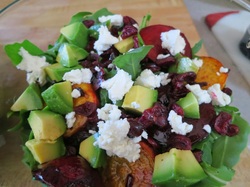 There is compelling evidence that a diet rich in fruits and vegetables can lower the risk of heart disease, stroke and cancer (with those eating seven or more servings daily showing lowest risk). Fruits and vegetables are also a great tool in weight control as they are naturally low in fat and calories and are filling. But how much is enough? The latest dietary guidelines call for six to twelve servings of fruits and vegetables a day (3 -6 cups), depending on one’s caloric intake. However, according to the Centers for Disease Control and Prevention (CDC) 2013 State Indicator Report on Fruits & Vegetables, adults in the US only consume fruit about 1.1 times per day and vegetables about 1.6 times per day. An easy way to remember all this is to echo the MyPlate mantra: make 1/2 your plate fruits and vegetables. Colors count too. It may sound corny, but as I told all the kiddos during my years in the field as a Child Health & Nutrition Specialist, we’ve got to “eat a rainbow a day”! Many of those disease-busting antioxidants are phytochemicals, which provide the varied pigmentation of fruit and vegetables. Incorporate the whites, deep oranges, purples, yellows, reds and greens. Green leafy vegetables are in fact most strongly associated with a reduction in risk of cardiovascular disease. Not quite at that 7+ a day mark? Here are some great ways to incorporate more fruits and veggies into the meals you’re already making: Boost your breakfast: - Add peppers, tomatoes, mushrooms or onions to your eggs for a delicious omelet, or pile the whole scramble on your favorite bread, tortilla, or bagel for a hearty breakfast sandwich. - Stir berries (fresh or frozen), dried fruit, or banana slices into yogurt, cereal, or oatmeal. - Make a smoothie. Combine some low fat milk or yogurt, 1/2 cup frozen berries and a banana for a super easy blended breakfast (add some spinach or kale for a super boost! Nut butters are also a divine addition) . Half the meat, double the veggies: In soups, salads, pastas, sandwiches, pizzas, and casseroles half the amount of meat and double the amount of veggies. You’ll be saving money and filling up with heart-healthy antioxidants and fiber. Do the dip! Go sweet or savory with apple wedges, pears, bananas, mango, or pineapple spears in fruit-flavored yogurt or go with raw veggies and hummus, creamy ranch, avocado, or zesty salsa. Salad time! Make your salad a meal by combining an array of colorful greens (let’s move past romaine y’all), crunchy veggies like carrots, radishes and cabbage with protein (nuts, beans cheese, egg, chicken, tuna,etc.). Beware of dressing overload by keeping it on the side. Keep produce where you can see it….that way you’ll be more likely to eat it. Keep your fruit bowl loaded on the counter, ensure pre-cut veggies are ready to go in the fridge and keep trail mix on hand in the car for an on-the-go snack. Don’t forget the freezer: Pre-cut fruits and vegetables are abundant and affordable options. Plop those frozen fruits into your blender or in your homemade baked goods and add those veggies to your boiling water when making pasta, rice, quinoa etc.
2 Comments
Brian
4/24/2014 09:45:31 am
Andie I love your site so far! The way you write is very enthusiastic and makes the reader feel motivated and capable of achieving these simple (but sometimes difficult to execute) healthy changes. Thanks! Can't wait to tell more people to go eat a rainbow!
Reply
Andie
4/25/2014 01:57:56 am
Thanks Brian! I look forward to enjoying a rainbowlicious meal with you soon.
Reply
Leave a Reply. |
AuthorHello and welcome! My name is Andrea Notch Mayzeles. I am a Certified Health Education Specialist, Mom, and Master of Public Health dedicated to the path of well-being. As a wellness professional I am committed to continued learning and am here to share research, recipes and musings on health, psychology, personal development, and parenting. I hope you enjoy! Categories
All
|

 RSS Feed
RSS Feed